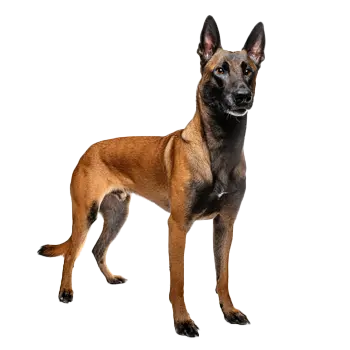American Kennel Club (AKC)
The AKC breed standard describes the Pastor Belga Malinois as a well-balanced, square dog that is elegant in appearance with an exceedingly proud carriage of head and neck. The dog should be strong, agile, well-muscled, alert, and full of life. Standing squarely on all fours, when viewed from the side, the topline, forelegs, and hind legs should closely approximate a square. The whole conformation gives the impression of depth and solidity without bulkiness. Males are typically more impressive and grand than females, who have a distinctly feminine appearance. The movement should be smooth, free and easy, seemingly never tiring, exhibiting facility of movement rather than hard driving action. The coat should be comparatively short, straight, hard enough to be weather resistant, with dense undercoat. Colors range from rich fawn to mahogany with black mask and ears. Correct temperament is essential, with the breed being confident, exhibiting neither shyness nor aggressiveness in new situations.
Fédération Cynologique Internationale (FCI)
Under FCI standards, the Pastor Belga Malinois is classified as one of four varieties of Belgian Shepherd Dog. The FCI describes these dogs as mediolineal, harmoniously proportioned, combining elegance and power, of medium size with dry, strong muscle, fitting into a square format. They should be rustic, accustomed to outdoor life and built to resist frequent atmospheric variations of the Belgian climate. Through harmony of shape and high head carriage, the Belgian Shepherd should give the impression of elegant strength. The coat in Malinois variety should be very short on head, ears, and lower legs, short on rest of body, and thicker on tail and around neck where it forms a slight collarette. The hair should be thick, close-fitting and of good firm texture with woolly undercoat. Movement should be lively and free at all gaits, with the breed being a good galloper, though normal gaits are walk and especially trot. The reach should be medium with even, easy movement and good rear drive.
United Kennel Club (UKC)
The UKC recognizes the Pastor Belga Malinois as one variety of the Belgian Shepherd Dog. According to UKC standards, this is an elegant, well-proportioned, medium-sized, square dog. By majestic carriage and harmony of form, the Belgian Shepherd gives the impression of elegant robustness. The dog should be hardy, accustomed to living in the open air and built to resist inclement weather and atmospheric changes. The Malinois variety should have hair that is short on head, exterior of ears and lower parts of legs, short on rest of body, thicker on tail and around neck where it forms slight collarette beginning at base of ear and extending to throat. The hindquarters should be fringed with longer hair. The coat should be thick, close and of good firm texture with woolly undercoat that conforms to the body without standing out or hanging down. Males should measure 24-26 inches at withers, females 22-24 inches. The temperament should show confidence and alertness, never shyness or viciousness.
Other Organizations
Various national kennel clubs maintain similar standards with minor regional variations. The Kennel Club (UK) recognizes the breed with standards closely aligned to FCI guidelines, emphasizing the working ability and sound temperament. Canadian Kennel Club standards mirror the AKC requirements with metric measurements. The Australian National Kennel Council follows FCI guidelines for the Belgian Shepherd varieties. All major registries emphasize that the Pastor Belga Malinois should never lose sight of its working heritage, requiring dogs to demonstrate sound temperament, proper structure, and the physical ability to perform the tasks for which the breed was developed. Judges are instructed to penalize any deviation that would impair working ability, including improper bite, missing teeth, incorrect coat, poor movement, or temperament faults.

